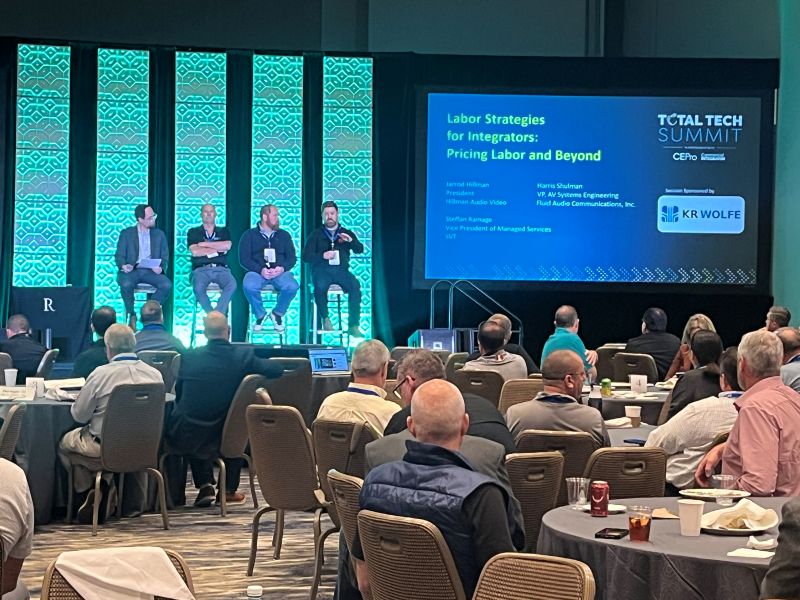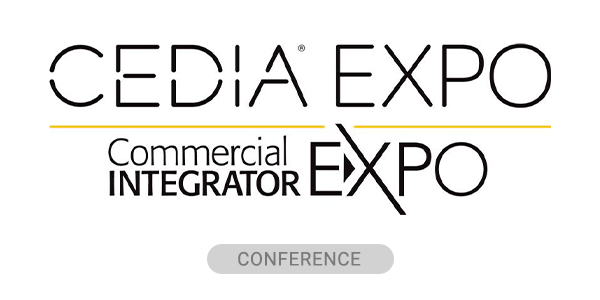At Total Tech Summit 2025, three industry veterans gathered to discuss one of the most critical topics facing AV integrators today: labor. From calculating the true cost of a technician to crafting winning pricing strategies, the panel dove deep into the complexities of labor management. Featuring the collective wisdom of Harris Shulman of Fluid Audio Communications, Steffan Ramage of SVT, and Jarrod Hillman of Hillman Audio Video, the session delivered actionable insights for integrators of all sizes.
The discussion revealed that mastering your labor numbers is not just an accounting exercise; it’s a fundamental pillar of profitability, project success and long-term business health. For anyone looking to sharpen their competitive edge, the lessons shared were invaluable.
Defining the Elusive Burdened Labor Rate
The conversation kicked off with a foundational question: What exactly is the burdened labor rate? While it sounds simple, the panelists quickly established that it’s a unique and dynamic figure for every integration firm.
Hillman defined it as the “true cost per hour for a technician.” This goes far beyond their hourly wage. It includes payroll taxes, benefits like health insurance and retirement contributions, uniform allowances, tool stipends and even the cost associated with their service vehicle. It is the all-in cost your business incurs for every hour that technician is on the clock.
Ramage built on this, emphasizing that this rate is not a static number. “The burdened labor rate is unique to your organization and it changes frequently,” he noted. The cost per hour for a lead installer is different from that of a project manager or a programmer. Understanding these distinct costs is the first step toward accurate job costing and ensuring every role on a project contributes to profitability.
Shulman added another layer of complexity, pointing to intangible costs like travel expenses. Estimating these accurately can be a significant challenge, especially for national projects, but they are a crucial component of the true labor burden.
The Secret Sauce: Calculating Your Unique Rate
So, how do integrators calculate this critical number? The panelists shared their distinct approaches, showcasing that there’s no single formula for success. Ramage revealed that his company, SVT, incorporates a wide range of expenses into the burden rate. This includes software licenses for tools technicians use in the field, vehicle costs, uniforms and a portion of company overhead.
This comprehensive approach provides a granular view of what each labor hour truly costs the business. In contrast, Shulman’s team at Fluid Audio Communications uses a set hourly rate that is adjusted based on the project’s region. They then add a separate overhead cost to this figure. This method allows for flexibility in a national market where labor rates can vary significantly from one city to another.
Hillman pointed out another variable: the technicians themselves. “The burden rate can vary between two technicians in the same role based on their tenure,” he explained. A senior technician with more vacation time has a different cost structure than a newer employee, a detail that data-driven companies track meticulously.
From Costing to Profit: Crafting a Pricing Strategy
With a firm grasp of labor costs, the next step is building a pricing strategy that ensures profitability. The panel stressed that meticulous planning is non-negotiable. Shulman, whose company frequently utilizes subcontractors, highlighted the importance of a highly specific scope of work (SOW). “We write a very specific scope of work to ensure labor costs are accurate,” he said. This clarity eliminates ambiguity and protects margins from unexpected labor overruns.
Ramage framed meticulous costing as a risk-evaluation tool. “We need to know our costs to evaluate the risk of a project and ensure a profitable margin,” he stated. He advocated strongly for fixed-fee pricing, arguing that it eliminates the cumbersome and often contentious process of managing change orders. By providing a firm, all-inclusive price upfront, you create a more transparent and positive client experience. “Price is not a strategy,” he declared, urging integrators to focus on the value and experience they deliver.
The Right Tools for the Job
Tracking these complex variables is nearly impossible without the right software. The panelists discussed their preferred tools for managing costs and maintaining a clear financial picture. While acknowledging the utility of a well-built Excel spreadsheet for estimates. Ramage championed the use of dedicated software for the ability to provide a comprehensive financial outlook on projects, bringing to light hidden costs that might otherwise be missed. This kind of data-driven approach is essential for making informed business decisions.
Hillman echoed this sentiment, emphasizing the need to be “data-driven.” Using software to track every cost associated with a project isn’t just about accounting; it’s about gathering the intelligence needed to price future jobs accurately and confidently.
Key Takeaways for AV Integrators
The session was packed with practical advice, but a few key themes emerged:
- Know Your Numbers: You cannot price for profit if you don’t know your true burdened labor rate. Invest the time to calculate this for every role in your organization.
- Be Data-Driven: Leverage software to track costs meticulously. This data is your most powerful tool for accurate pricing and risk assessment.
- Price for Value, Not Hours: Move away from cost-plus thinking and toward fixed-fee or project-based pricing. Focus on delivering a premium experience and clear communication, making price a secondary part of the conversation.
- Clarity is King: A detailed scope of work is your best defense against scope creep and eroding margins, whether you’re using in-house technicians or subcontractors.
By embracing these principles, AV integrators can move beyond simply covering costs and begin to build a robust, profitable and sustainable business model that stands out in a competitive market.






